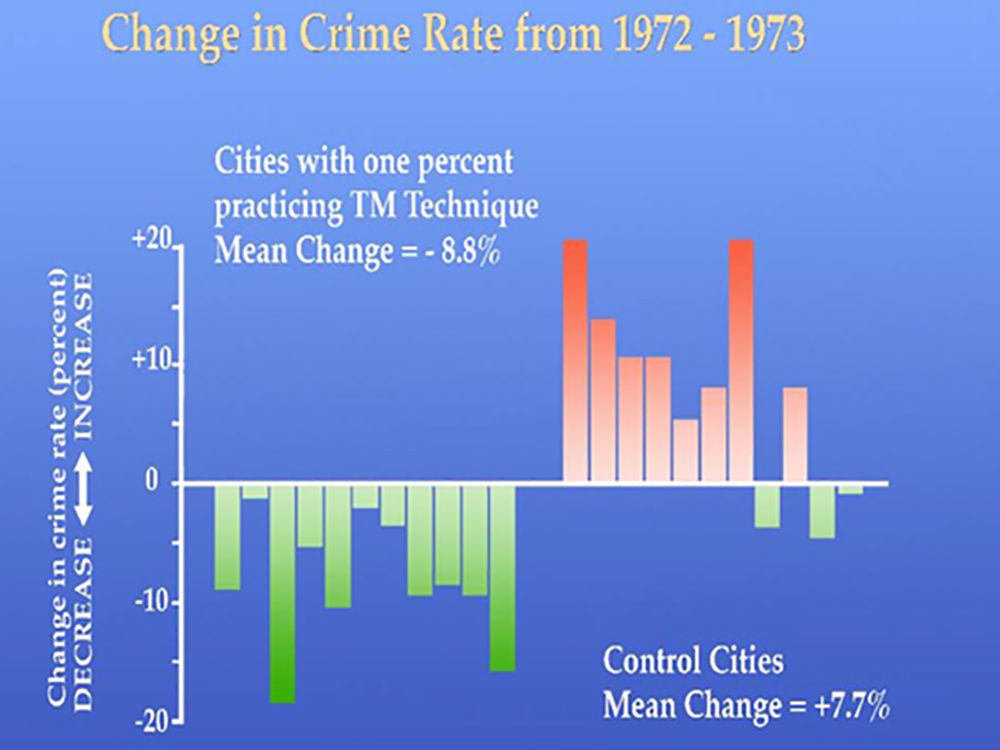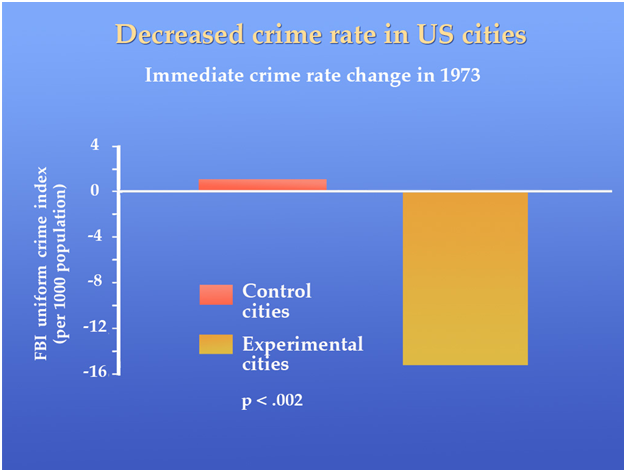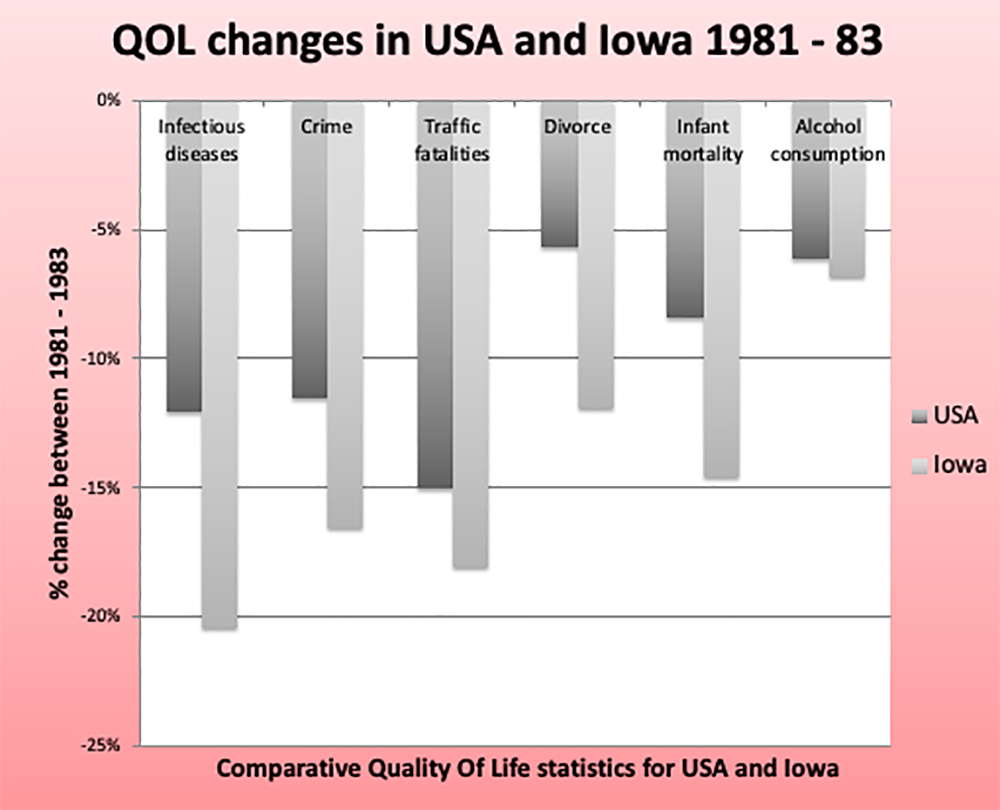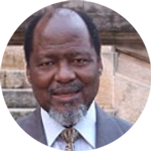Sociological research on Transcendental Meditation
Adapted from: Chalmers R. Summary of Scientific Research on the Transcendental Meditation and TM-Sidhi Programme 2019.
The relationship between individual and society
Every individual continuously contributes to, and is influenced by, the quality of life in society. In the analysis of Maharishi Mahesh Yogi, founder of Transcendental Meditation and its advanced programmes, the quality of life in any social group, from a family to the whole world, is governed by the collective consciousness of all the members of that group. Just as the thinking and behaviour of individuals is determined by their level of consciousness, so the functioning of society is governed by the degree of integration in its collective consciousness. When collective consciousness is coherent and free from stress, a powerful influence of positivity and harmony permeates all areas of society, benefiting everyone. On the other hand, when stress builds up in collective consciousness, its negative and discordant effects pervade the whole community. If not relieved, accumulation of stress in collective consciousness inevitably leads to disorders of collective health, such as crime, violence, social turbulence, and economic failures, eventually threatening the cohesiveness of society as a whole.
The field effect of consciousness
According to Maharishi, the influence of the Transcendental Meditation technique and group practice of its advanced programmes on society does not depend primarily on social interaction on the surface level but results from enlivenment of a universal source of coherence and harmony — Transcendental Consciousness — which is fundamental to both individual and collective consciousness. When individuals experience the deep inner silence of transcendental consciousness during Transcendental Meditation, a coherent and life-supporting influence is generated not only at all levels of individual life, but also in the collective functioning of the entire society. Based on this principle, Maharishi predicted in 1962 that if even 1% of the population were to practise Transcendental Meditation, positive changes would be observed not only in individual lives but also throughout the community. With group practice of the advanced TM-Sidhi programme it was hypothesised that even the square root of 1% of a population would be sufficient to generate significant improvements in quality of life for the whole society.
Research studies
A selection from 20 peer-reviewed studies and 50 demonstrations, employing the most rigorous experimental designs and statistical methods available in the social sciences, is included below. These studies and demonstrations provide evidence for a phenomenon that has become known as the Maharishi Effect. Based on robust research, the authors anticipate that investment in establishing and maintaining coherence-creating groups will be readily recouped through the massive fiscal benefits consequent upon reduced conflict, increased international peace and cooperation, reduction of major social problems (such as crime, accidents, and unemployment), and improved economic performance.
The references in the text below refer to a list of 31 published research studies on this topic.
To view this list, click on the Expand link below
Reduced crime
The Maharishi Effect prediction was first investigated in 1974 in a number of American cities where 1% of the population had learned Transcendental Meditation. When the 1% threshold was reached, a substantial reduction in crime rate was observed, in contrast to previous crime trends in these cities and to the continuing rise of crime in matched control cities with far fewer people practising Transcendental Meditation.(1)

This result has been confirmed and extended by larger and increasingly more rigorous investigations, which have demonstrated that the percentage of the population practising Transcendental Meditation is a reliable predictor of decreases in crime, suicides, and accidents even after controlling for demographic factors that are known to influence these parameters.
For example, scientists found that the observed improvements in quality of life could not be explained by changes in population size and density, residential stability, college population, ethnic distribution, unemployment rate, average income, percentage of the population living below the poverty level, age distribution, average level of education, police coverage, or previous crime trends. Further research found evidence of a direct causal relationship between numbers practising Transcendental Meditation and reduction of crime rate in two separate random samples, one of 160 cities and the other of 80 metropolitan areas in the United States.(2,3)


Reduced fatalities and crime
A series of 4 studies examined the effects of a large assembly practising Transcendental Meditation and the advanced TM-Sidhi programme in Iowa from 2007 and 2010, when group size consistently exceeded (or was near to) the critical threshold predicted to generate the Maharishi Effect for the United States as a whole.(4,7)
Compared to trends in the 50-month pre-intervention period (when group size was well below the critical threshold), the 48-month intervention period showed cumulative reductions in US national mortality rates from: homicide (21.2% decrease); motor vehicle accident fatalities (13.5% decrease); other accidental fatalities (20.5% decrease); drug-related deaths (20.5% decrease); and infant mortality (12.5% decrease).(4-7)
Reductions were also found for rates of violent crime (18.4% decrease) and murder (28.4% decrease), measured in a sample of 206 urban areas (total population 60 million in 2010). Interestingly, although these urban areas initially had higher murder rates than the country as a whole, they experienced a greater percentage decline during the experimental period.(7)
The authors examined other possible explanations for these results, but none were found to account for the decreases in these usually unconnected variables. In contrast to all previous major economic downturns since World War II, violent crime failed to rise during the severe recession that followed the global financial crisis of 2008. Also, the experimental period coincided with an increase in the number of 18-25 year-olds in the population which would normally be associated with an increase in crime. By 2010, prison releases exceeded prison admission for the first time since records began.(4,7)
Prospective study
4,000 participants in the TM-Sidhi programme gathered in Washington DC for a six-week demonstration project in 1993. Predictions were lodged in advance with a 27-member independent review panel and advertised in the Washington Post.(8) The results provide evidence of a dosage effect: when numbers participating increased, the effects were greater. Findings showed a 23.3% reduction in total violent crime during the project period, as well as increased approval ratings for President Clinton. In addition, accidents, emergency psychiatric calls, hospital trauma cases and complaints against police all decreased, while a quality of life index improved.(9,10)

Reductions in crime rates
were also observed when groups practising the TM-Sidhi programme exceeded the square root of one per cent of the population of the Union Territory of Delhi, India; Metro Manila, Philippines; and Puerto Rico, USA.(11)
Metropolitan Merseyside
A study in the UK documented sustained crime reductions when a coherence-creating group was maintained over a number of years. During this period, Merseyside crime rate declined from being the third highest among the eleven largest UK metropolitan areas to the lowest.(12)

Quality of life
Sustained improvements in multiple indicators of quality of life were also found in several US studies, including reduced fatalities due to homicide, suicide, and motor vehicle accidents, and improvements in economic indicators. These changes occurred when a stable coherence-creating group in Iowa exceeded the size predicted to influence the USA, or both the USA and Canada.(13,19) Again, these studies demonstrated a dosage effect: when the group practising the TM-Sidhi programme was larger, the effects were greater.
War intensity
During the Lebanese war, in the summer of 1983, intensity of conflict and number of war fatalities were reduced on days when a group practising the TM-Sidhi programme in Jerusalem over a 2-month period reached sufficient size to generate the Maharishi Effect for the region.(20) Improvements were also found in composite indices of quality of life (including data on crime, motor vehicle accidents, fires, national mood, and the stock market) for both Jerusalem and Israel when the group was large enough to predict effects at the city or national levels.(20,22)


Replication of the war-intensity study
The finding of reduced war in Lebanon was subsequently replicated for all seven assemblies that comprised TM-Sidhi groups of sufficient size to predict the Maharishi Effect for the region during the peak of the conflict between 1983 and 1985. This included groups located in or close to Lebanon and larger assemblies further afield. Statistical analysis, which controlled for temperature, holidays, and weekends, demonstrated that the results were independent of alternative explanations. Multiple indicators of reduced conflict replicated the findings when combining intervention periods, including 66% increase in cooperation between antagonists; 71% reduction in war-related fatalities; 68% decrease in war-related injuries; and 48% reduction in levels of conflict.(23)
Economic development
Increased national economic strength and competitiveness in New Zealand and Norway. Scores on the Institute for Management Development (IMD) Index of National Competitive Advantage increased significantly for New Zealand and Norway when the number of people practising Transcendental Meditation exceeded 1% of the national population, in comparison to 44 other developed nations over a 7-year period. Subsidiary analysis and Organisation for Economic Co-operation and Development (OECD) data confirmed that the observed economic improvements were unusually broad-based, sustained, and balanced in nature, with five years of high growth, low unemployment, and low inflation. For New Zealand, a cost-benefit analysis of coherence creation through Transcendental Meditation conservatively estimated the gain to the nation at $320 for every $1 invested in implementing the programme.(24)

Cambodia
Group practice of the Transcendental Meditation and TM-Sidhi programme in Cambodia between 1993 and 2008 was associated with a 96.2% decline in socio-political violence compared to the preceding three years.(25) The reduction in violence commenced in January 1993 with the establishment of Maharishi Vedic University (MVU) in Cambodia, when more than 550 students began practising Transcendental Meditation twice daily in a group. A case study noted that in 1990, Cambodia, devastated by decades of war, was the poorest country in the world. After the establishment of Maharishi Vedic University, Cambodia's GDP growth rates averaged 8.9%, and poverty was reduced by 63% between 1994 and 2008. By 2010, Cambodia was ranked 63rd out of 152 countries on the international scale of poverty, an unprecedented jump of 89 places in less than one generation.(26)
Mozambique
A dramatic transformation from the most extreme poverty and decades of war to lasting peace and growing prosperity was also seen in Mozambique, where in 1993 President Joachim Alberto Chissano introduced Transcendental Meditation to 18,000 soldiers, with 3,000 also learning the TM-Sidhi programme. 30 years of war ended (followed by a stable peace that has lasted for the past 25 years), and national prosperity soared, including an economic growth rate of 19% (when only 6% was predicted). Traffic accidents remained stable despite a 300% increase in the number of vehicles in circulation.(27)

President Joachim Alberto Chissano
Global influence
When three large assemblies of groups practising the Transcendental Meditation and TM-Sidhi programme – in Iowa, the Netherlands, and Washington DC – achieved the size predicted to generate the Maharishi Effect for the entire world, a 72% reduction in international terrorism and a 33% decrease in international conflict were observed.(28)


International relations
A series of four studies examined the impact of large groups practising the Transcendental Meditation and TM-Sidhi programme on improving relations between the United States and Soviet Union in the years preceding the end of the Cold War.(29-31) Again, these four studies showed a dosage effect: the larger the group, the bigger the impact. The authors also examined the rise of the former leader of the Soviet Union Mikhail Gorbachev who is often given the credit for improving superpower relations. But in the fourth of these studies, which examined the influence of four large temporary groups practicing the TM-Sidhi programme together, three of the groups occurred before Gorbachev became leader of the Soviet Union.(31)
The reference numbers in the above text refer to a list of 31 published research studies on this topic.
To view this list, click on the Expand link below
Take the first step
Public introductory talks are either online or in-person.
These are advertised under each location. If your local Centre is not advertising a webinar, please call them direct. Otherwise ...
...register for an info session





